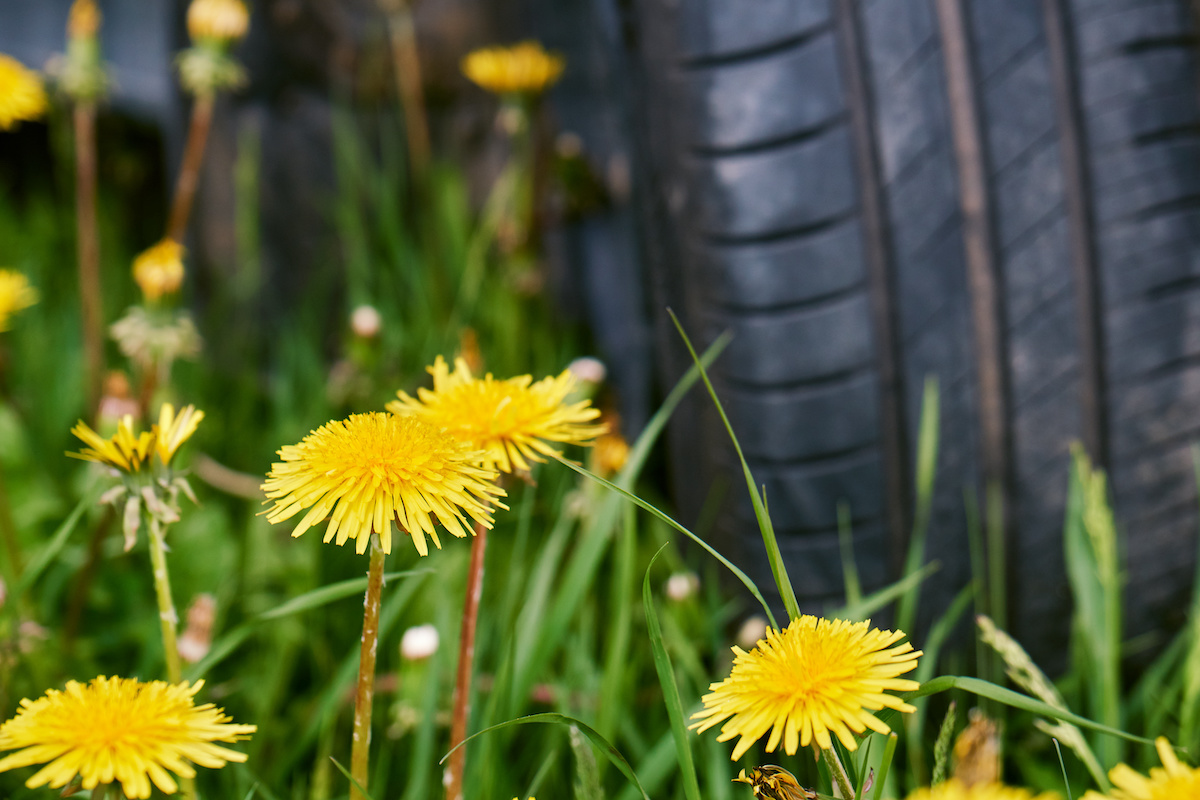October 23, 2022
Driving with Dandelion Tires: The Rubber Tree Alternative
The splendors of the rubber tree were discovered thousands of years ago by the ancient Olmec, Maya, and Aztec tribes. Since then, rubber has evolved into many things we use today, including the tires that drive our cars and trucks. The demand for tire production continues to grow, and with it comes environmental stresses, pushing for alternative sources for manufacturing tires, with an unlikely candidate being the dandelion. We’ll look at how tires are made, rubber trees and their environmental factors, and why we should care about dandelion tires in the first place.
How Tires for Driving are Made Using Rubber Trees
Natural rubber is the primary material used for manufacturing tires, and 99% of it is extracted from the rubber tree, or Hevea brasiliensis. Rubber starts as a milky liquid found in the tree’s bark, and once tapped, the liquid goes through a mixing, squeezing, and drying process. Synthetic rubber, made from crude oil, is also added to the mixture, making rubber sheets ready for production. The sheets are then wrapped around a center rotating drum along with other necessary chemicals and materials to compose all aspects of a tire. These tires are found on our cars and trucks driving on America’s most beautiful roads.
Rubber Tree Stresses and Dandelion Tires Alternatives
Rubber trees need a subtropical climate to grow, making them native to the Amazon rainforests in South America. These forests only contain a limited number of natural resources, and with the demand for rubber products growing, more land and trees are needed. Rubber trees are grown in agricultural fields close to one another and are becoming susceptible to a fungal leaf blight that can threaten fields. Rubber trees take about six years of maturing to develop the sap necessary for rubber making and can live up to 100 years. With dwindling land for planting and threats of fungal disease, synthetic rubber from environmentally unfriendly fossil fuels is combined with natural rubber to make tires. These environmental stresses circling tire production are prompting tire makers to look for other natural sources.
Dandelion Tires Driving the Future
A future of clean energy and working closer with mother nature is a vision for many. Favoring innovation and a need for cleaner fuel, the evolution of the semi-truck has started and continues with environmentally friendly tires. With growing concerns regarding tire manufacturing and the effects of rubber tree cultivation, the need to find alternatives is more prevalent than ever, with developers looking at an unusual candidate: the Russian dandelion. The cultivation of Russian dandelion rubber goes back to 1931 when Soviet scientists began looking for alternatives due to the scarce availability of Hevea tree rubber during World War II. The Dandelion plant proved highly resilient, abundant, and easy to grow. Still, the process was eventually abandoned, and Hevea tree rubber returned to being the world’s cheapest and most widely used rubber. Years later, hopes of paving the road for tires made from dandelion rubber were revisited. Professor Dirk Prüfer, and Dr. Christian Schulze of the Fraunhofer Institute for Molecular Biology and Applied Ecology IME, worked with Continental Tire to test tires manufactured from Russian dandelion rubber, concluding the tire was equivalent to Hevea rubber tree tires. Does the question remain, which companies will take up manufacturing dandelion tires? Putting dandelion tires on semi-trucks is a discussion for the future. Still, it may not be too far off with Freightliner trucks and other manufacturers favoring innovation and clean energy.
Why We Should Care About Driving with Dandelion Tires
Besides wanting to make the world more environmentally friendly, why should truckers care what their tires are made of? The impact of the manufacturing process of tires reaches further than just deforestation and the use of fossil fuels. With a growing demand for tires, synthetic rubber was invented, made up of plastic polymers. A long-haul trucker spends plenty of time driving, and their tires put in tremendous work. As tires rank up in mileage, they begin to wear and tear. The result is tiny plastic polymers, known as microplastics, being thrown off and released into the air. A study in 2017 conducted by Pieter Jan Kole for the International Journal of Environmental Research and Public Health stated that roughly 10% of microplastics found in oceans could be attributed to tire wear and tear, making it as important as waste from plastic bottles and bags. These microplastics travel to oceans and waterways and can eventually make their way into the food chain. Long story short, tires are usually made with a mix of natural and synthetic rubber, which can be deadly to our air quality, oceans, and even the food we eat. R.J.B. Peters and his team, in their report, Microplastics in the Aquatic Food Chain, found that hundreds of species of animals had ingested microplastics when looking at the aquatic food chain.
A future of driving with dandelion tires might still be far off but is worth looking into for the sake of the environment



